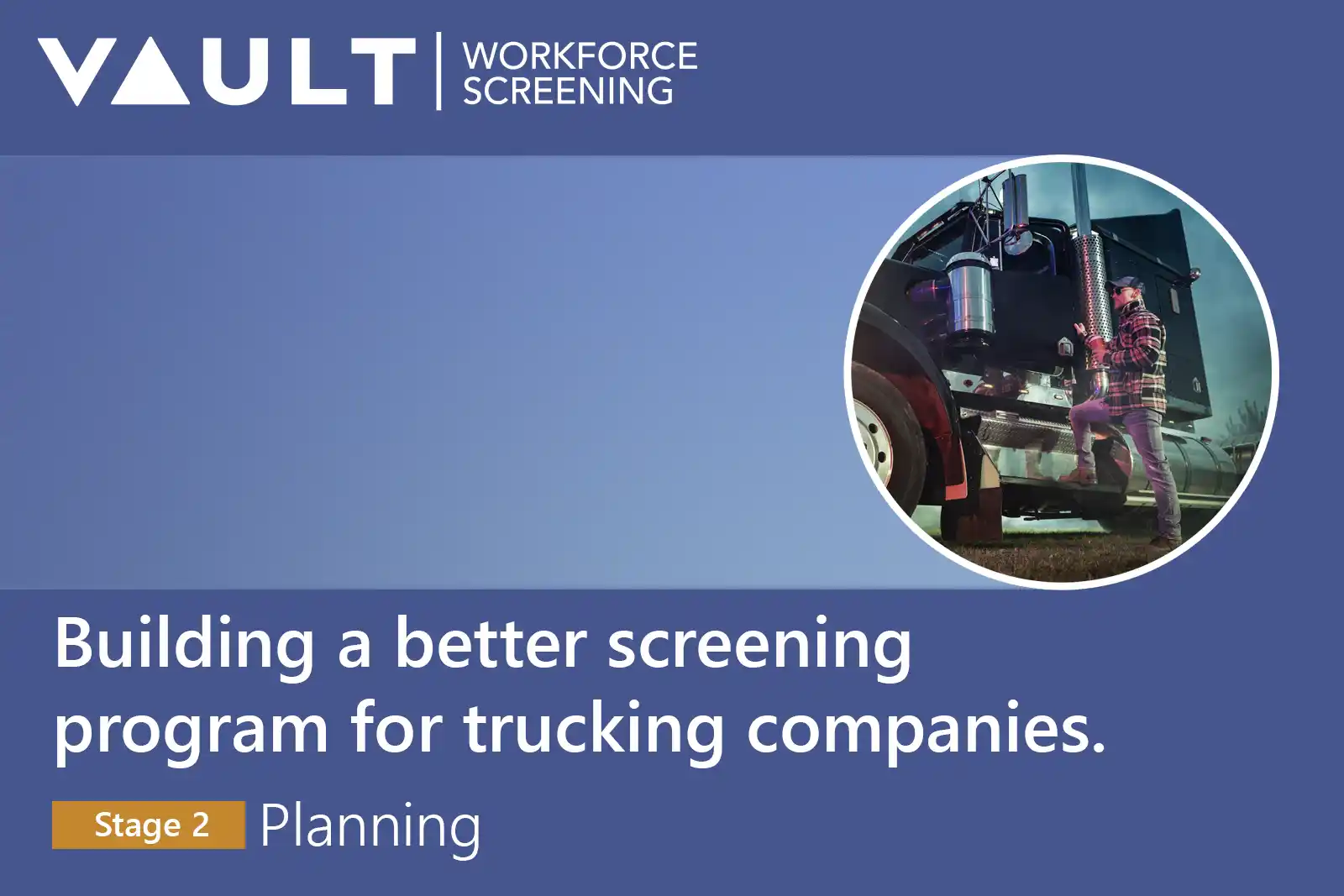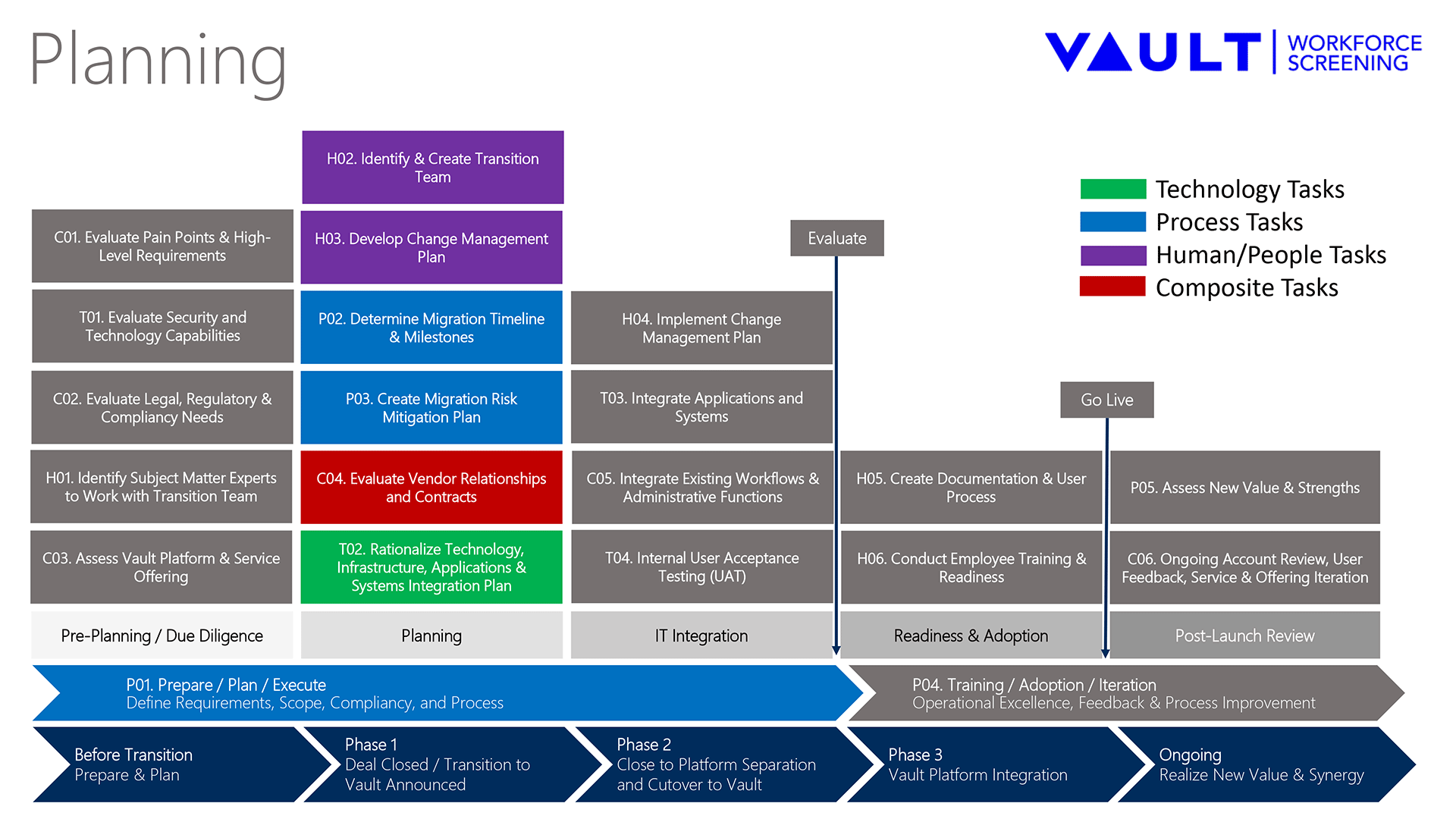A better screening program for trucking companies. Stage 2: Planning
May 6, 2022
In this series, we're covering 19 detailed steps you can (and should) take, throughout 5 clearly defined stages, and how you can best approach completely auditing your existing screening program, vetting new vendors, and ultimately rebuilding your program to solve for all you needs.
It will help you understand the big picture and how you can best propose new solutions to optimize HR in your organization. The business case you build will include realistic expectations and clear understanding of resource needs to be successful.
Yesterday we talked about the first stage in rethinking your screening program, workflow, vendors, and overall strategy.
Today, we’ll be looking at the next stage, which involves the actual planning.

Stage 2: Planning
In the planning stage, you’ll begin work with all your SME’s, vendors, and stakeholders to build teams, plans, and expectations. At the end of this stage, all stakeholders should feel comfortable with the go-forward strategy, as a realistic and attainable roadmap for success.
We’ve broken out this stage into 6 key steps:
1. Identify & Create Transition Team
In this step, you’ll be using requirements gathered in the Pre-planning/Due Diligence phase to create a transition team dedicated to the migration project.
- Identify all team members who will be involved in migration project. This team will be involved throughout the process, and work with pre-determined SME’s as well as ATS and outside vendors to ensure smooth migration.
Vault can help you identify and assemble the optimal team to ensure your seamless migration. An assigned Transition Team Leader should continue to act as the project lead throughout the migration, facilitating tasks, communication, etc., that are necessary at different points of the process. The team will communicate directly with SME’s and outside vendors as needed, ensuring smooth progression of the project from start to finish.
2. Develop Change Management Plan
By developing and maintaining a well-defined change management plan now, you can help prevent slowdowns and frustration typically present in any software platform change.
- First, you’ll want to outline the goals and objectives of the migration, which should now be documented from Stage 1.
- Communicate those goals/objectives to all stakeholders and ensure alignment with each.
- Outline how decision making, and information sharing will be conducted throughout migration, and communicate to all team members.
Your Transition Team Leader should help gather and define the goals and objectives of the migration plan. Upon making sure all stakeholders agree with those goals, the plan can be created. The plan, along with expectations and process can then be explained to all SME’s and stakeholders.
3. Determine Migration Timeline & Milestones
In this step you will be developing your migration timeline and demonstrable milestones to set expectations and measure project success throughout the stages. Work closely with all internal and external stakeholders to double check you have a clear understanding of what is involved with each step and provide detail when planning your deliverables. Create demonstrable milestones at logical steps throughout the project to make sure you are staying on track. Communicate any obstacles or changes as soon as possible so everyone remains in the loop on progress.
- First, you will want to break the project into stages and tasks, creating milestones for each successful stage being completed. You will most likely have numerous concurrent moving pieces throughout each stage, running at varying speeds. Your milestones should occur when those pieces come together.
- Work with SMEs, preparing them for expectations and explaining where and how they will be needed throughout. SMEs should understand what is being asked of them each step of the way.
- Plan for regular status update meetings, where the project will be adjusted as necessary to ensure successful completion. Your Transition Team Leader should coordinate and run weekly status meetings to bring everyone together on status, and make adjustments to deliverables, calendars, etc. accordingly.
Vault can work with your team to create a realistic project plan and expectations. Timelines and milestones should be realistically set, and regular status meetings put on the calendar. SMEs will be given tasks and needs, allowing adequate time for proper planning for when they will be needed. The project timeline should be adjusted as necessary throughout, and an up-to-date version should always be accessible for all stakeholders to review throughout.
4. Create Migration Risk Mitigation Plan
Creating a Risk Mitigation Plan will prepare your organization for any potential IT issues that may arise, by effectively conducting a thorough risk assessment, and creating a mitigation strategy prior to beginning the actual integration and migration.
- Identify all foreseeable risks by working closely with your IT team and all technology vendors involved in the project.
- Involve your SMEs to develop realistic mitigation strategies to prevent or overcome issues should they occur.
- Develop a business continuity and disaster recovery plan as it pertains to the rollout. Be ready to roll back, or take other measures should an issue arise. Make sure your IT team and all vendors monitor critical points throughout your cutover.
Vault will work with your team to identify any foreseeable risks involved in the project from the screening platform perspective. Your organization will benefit from Vault’s experience in similar projects combined with internal risk known by your IT team. The Transition Team Leader should then work with appropriate SMEs to develop a robust risk mitigation plan prior to undertaking the actual integration and implementation.
5. Evaluate Vendor Relationships & Contracts
Now that your plan is set, you can begin reviewing, contacting, cancelling, and/or renegotiating appropriate vendor relationships and contracts as necessary to ensure a smooth, manageable, and transparent migration.
- Begin by reviewing all impactful vendor contracts and relationships. Produce a high-level view of landscape for analysis by key stakeholders.
- Once you have analyzed all existing contracts and relationships, along with requirements, begin negotiating and/or renegotiating contracts as necessary for hardware, software, and services needed with your new solution.
Vault will work with your Transition Team Leader and SMEs to better understand your current process and vendor relationships. Often, these existing relationships and contracts can remain unchanged. However, should there be any additional requirements and or vendor relationships necessary, they should be presented to key stakeholders before the project commences.
6. Rationalize Technology, Infrastructure, Applications & Systems Integration Plan
While evaluating the current state of IT landscape in HR/Screening systems, you will most likely encounter areas which can be optimized, minimized or decommissioned as necessary. Eliminating redundancies or unnecessary vendors and contracts often yields unexpected cost savings in your overall HR Tech spend.
- From a background screening perspective, review all technology, infrastructure, and applications used by your existing vendor. Some may make sense with your newly proposed solution, and some won’t.
- Identify which vendors will be needed by matching requirements to the needs of Vault’s screening platform and your new program.
- Present a comprehensive recommendation on optimization, consolidation, decommissioning, etc. to your IT team and appropriate stakeholders.
Vault can work closely with your Transition Team Leader and IT team to ensure you have the right technology, infrastructure, and software in place to support the new integration and program. Additionally, we will identify areas you may be able to retire, ultimately avoiding application/resource bloat and saving money moving forward.
Stay tuned for tomorrow's post, where we will share 4 steps to get through Stage 3: IT Integration. You'll learn how to successfully implement and test the plans you developed in Stage 2.
Below are links to all stages for this program:
We've mentioned Vault helping you along the way. We are currently offering a free comprehensive 30 minute program review which can help you make sure there are no red flags. A clearly defined program and policy ensures consistency, accuracy, and efficiency in your hiring process. Schedule today and we'll step through every aspect of your program and where you may be able to improve. There is no obligation or risk involved, and you'll receive a free report you can review with team members following the consultation.

The information and opinions expressed are for educational purposes only and are based on current practice, industry related knowledge and business expertise. The information provided shall not be construed as legal advice, express or implied. Consult with legal counsel before any action is taken or not taken in relation to information disseminated in this resource.

